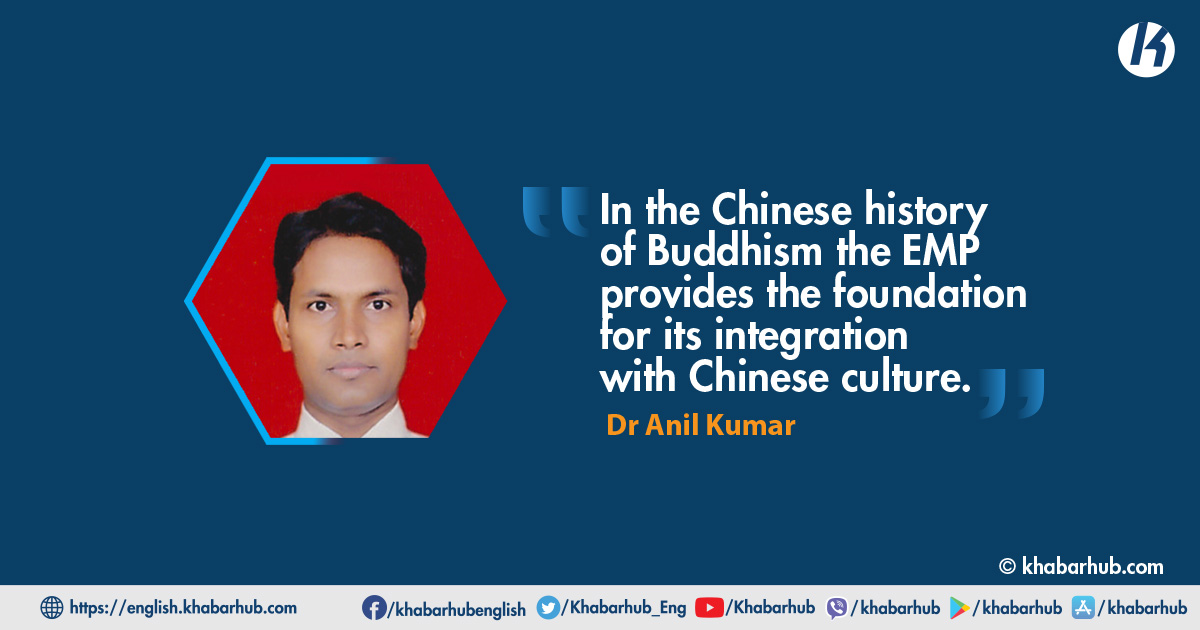The Early Medieval Period (EMP henceforth) is dated from the collapse of the Western Han in 220 AD until the reunification of China under the Sui dynasty in 589 AD.
This period witnessed so many developments that shaped Chinese history and culture. The rise of various Buddhist kingdoms in China in this era certainly figures among them.
This period provides the socio-political and philosophical context in which a foreign religion like Buddhism got integrated with the Chinese culture.
The Chinese historians also describe this part of Chinese history as the Six Dynasties period (Liu Chao ) in which six Han-ruled dynasties came to power each with Jiankang (modern Nanjing) as their capital.
In this paper, I will select four areas of the Chinese culture that were impacted the most during the EMP. They include philosophy, religion, architecture and language. However, before touching on these themes l briefly discuss the arrival of Buddhism in China.
Buddhism’s Arrival in China
As a historian of China, I see the introduction of Buddhism into China very timely. The Han empire started collapsing in the second half of the second century AD.
Confucianism too was losing its previous prestige since it became the state ideology under emperor Wu Di. The Chinese scholar-gentry class was looking for alternative schools of thought such as Daoism, “Dark Learning “ (Xuan Xue), and Buddhism. Out of these Buddhism emerged as the most important school of thought in the post-Han period.
The first written reference to Buddhism in China is dated 65 AD. This source mentions Ming Di’s brother worshipping the Buddha along with Huanglao, a Daoist divinity.
Although Buddha had said that one is responsible for his own karmas, there were Buddhists in China who claimed that good karmas can be transferred to one ancestor, a belief underlying the making of Buddhist images and the Ghost Festival.
Regarding the year of the arrival of Buddhism, there are many apocryphal stories. One such often-cited story is about Emperor Ming’s (r. 58–75 CE) dream of a mystifying foreign deity with a golden hue, which one of the court advisors identified as the Buddha.
Consequently, the intrigued emperor is said to have sent a western-bound expedition in search of the deity. The expedition purportedly brought back the first Buddhist scripture to China, the Scripture in Forty-two Sections (Sishier zhang jing).
According to later versions of the story, the expedition sent by Emperor Ming also brought two Buddhist monks- Kashyapa Matanga and Dharmaratna- to Luoyang, the Han capital of Han China.
In their honor, the emperor ordered the construction of the White Horse Temple (bai ma si), the first Buddhist temple in China in 68 AD.
Buddhism and Chinese Philosophy
There was a great void in the Chinese scholar-gentry class post-Hans. The metaphysics of Confucianism based on the New Text failed to answer the gentry class cosmological queries.
The quest led to a new trend in Chinese philosophy called the ‘Dark Learning’ (Xuan Xue). It was intended to answer questions like gnostic and ontological problems such as, the relation between “original non-being” (本無) and the world of phenomena, the presence or absence of emotions in the Sage, the nature of music, the extent to which words can express ideas.
Their interest in ‘emptiness’ finally led to the emergence of early Chinese gentry Buddhism around 300 AD. The translation of the Pragyaparamita sutra during the second half of the 3rd century awaken the Chinese scholar to the highly metaphysical concepts including Sunyata (‘emptiness’).
The Chinese found similarities in Sunyata and Chinese philosophy of Laozi and Zhuangzi and the Buddhist doctrine of emptiness attracted the Chinese intellectuals’ attention and interest so they also started to study the Buddhist teaching.
There emerged eight different Buddhist schools of thought and four of them were more influenced by Chinese thought and became distinctive Chinese Buddhist schools. They are Tiantai, Huayan, Chan and Pure Land.
Buddhism and the Chinese Religious Universe
Buddhism introduced in China and which had a major impact on the Chinese civilization was the Karma and Reincarnation. They greatly enriched the Chinese vision of the afterlife.
The Hans did not see their dead through the Karmic lens of reward and punishment. For them, the right burial ritual rather than conduct determined the fate in the underworld.
However, the Buddhist doctrine of karma (yinguo) linked the fate of the dead in terms of his rebirth in heaven or hell, with his conduct.
Buddhist rituals brought to bear the spiritual power of monks and Buddhas to redeem ancestors from hell and secure for them a rapid rebirth in a pure-land paradise (Sukhavati).
Although Buddha had said that one is responsible for his own karmas, there were Buddhists in China who claimed that good karmas can be transferred to one ancestor, a belief underlying the making of Buddhist images and the Ghost Festival.
There were massive developments in the Chinese temple building activities in Luoyang between 494 AD 534 AD. Luoyang became the center of Northern Buddhism. “Temples of Luoyang” (Luoyang qielan Ji), written in 547 by YangXuanzhi, describes gardens in many of the Buddhist temples.
Similarly, Nirvana and Boddhisatva ideas led to a new kind of ruler in China called the ‘Boddhisattva emperor’. He worked not just for the security and welfare interest of his people but also for their nirvana. The Wu emperor of Liang (also called, the ‘Second Ashoka’) as a Boddhisatva, publically chanted the Buddhist sutras during his reign.
In the fifth century, many Chinese dynasties provided state patronage to Buddhism. In the south, the Eastern Jin court, after several debates, ruled that Buddhist monks need not bow to the emperor. This reflected to an extent the weakness of the emperor and the avid patronage of Buddhism by several leading families.
On the other hand, the Buddhist concept of a chakravartin ruler gave the already sacred position of the Chinese emperor an additional splendor as a chakravartin, “wheel-turning” king or cosmic overlord. Thus emperors invoked the rhetoric of Buddhism to articulate the newly revived imperial power, even as they accrued spiritual merit for their dynasty and people.
An important dimension of Chinese religiosity in this period was that mountains became sacred as they were seen as abode some bodhisattvas. Mount Wutai, for example, was considered to be above Bodhisattva Manjushri. The Manjushri cult was popularized in the 5th century after the translation of sutras like Mahaparinirvana and Avatamasaka.
Buddhism and Chinese Architecture
The spread of Buddhism greatly influenced Chinese architecture. To illustrate, Buddhist architecture became the feature of urban life in EMP with the introduction of multi-storeyed pagodas.
This style was inspired by an account in the Lotus Sutra of a great bejeweled, seven-story tower. The premier example was the first Yongning Temple built in 467 AD. It included three large halls and a seven-story pagoda that was the highest construction inChina at the time.
In order to express new concepts in Buddhist Sanskrit literature a large number of new Chinese words were created both through translation and transliterations.
Chinese pagodas also converted the rounded earthen mound of the South Asian stupa into the towering pagoda to house the sacred buried relics of Buddha at its center.
There were massive developments in the Chinese temple building activities in Luoyang between 494 AD 534 AD. Luoyang became the center of Northern Buddhism. “Temples of Luoyang” (Luoyang qielan Ji), written in 547 by YangXuanzhi, describes gardens in many of the Buddhist temples.
Some of these used rare plants and artificial hills to construct on earth the garden scenes depicted in Buddhist visions of paradise (Sukhavati), as shown in the cave paintings at Dunhuang. In the garden, there used to be a meditation building containing monastic cells.
Grottos were another type of Buddhist architecture that got integrated with the culture. In the 3rd century, Chinese Buddhists began to build grottoes and Xinjiang is the first area where grottoes were hewn.
Grottoes are decorated with painted sculptures, carvings and frescos. Craftsmen revealed real-life pictures and their understanding of the society in these artworks, which gave them great historical and cultural value.
The Mogao Caves (or Dunhuang Caves)are the best known of the Chinese Buddhist grottoes and, along with Longmen Grottoes and Yungang Grottoes. The first Mogao caves were dug out in AD 366 as places of Buddhist meditation and worship.
Buddhism and Chinese Linguistics
In order to express new concepts in Buddhist Sanskrit literature a large number of new Chinese words were created both through translation and transliterations.
According to Victor Mair, there are 35000 words in the Chinese language of Sanskrit origin. Today these words are so common in usage that we do not even know their Sanskrit origin. To illustrate, we use Shijie 世界 to mean ‘world’, but ancient Chinese people used Tianxia 天下 to mean the world. Shijie 世界 is originally from Buddhist literature, shi 世 denotes time, Jie 界 denotes space.
Buddhism also got integrated with the Chinese culture in this period at the level of religion, art and culture, and language and literature.
Similarly, the pluralizing suffix ‘men’ 们 has its origin in ‘gana’ (Devagana, Mitragana, etc.). Some transliterations include Chan 禪 for dhyana or meditation, Ta 塔 for Stupa or Pagoda, Louhan 羅漢 for arhat, worthy one, Nianpan 涅槃 for nirvana.
Under the impact of Buddhist translations, the Chinese language started using more disyllabic and polysyllabic than monosyllabic words. Finally, the four tones in the Chinese language were created during the process of sutra recitation during the EMP.
To conclude, in the Chinese history of Buddhism the EMP provides the foundation for its integration with the Chinese culture. Centrifugal forces ascended in China for the next 400 years post-Hans.
The scholar-gentry now faced a new set of questions beyond this worldliness of Confucianism, and hence turned to Buddhist metaphysics.
Buddhism also got integrated with the Chinese culture in this period at the level of religion, art and culture, and language and literature.
The initial process of integration peaks under the Tang dynasty, which forms the Golden Age of Chinese Buddhism in which China became the new center of Buddhism.









Comment